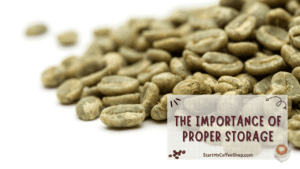Green coffee beans are the raw, unroasted seeds of the coffee plant that have enormous flavor potential when roasted. Whether you’re a coffee connoisseur or a home roaster, appropriate green coffee bean storage is critical to preserving its freshness and quality. Storing these beans correctly can have a considerable impact on the final brew’s quality and flavor.
To store green coffee beans, you should place them in a cool, dry, and dark place. Use airtight containers to prevent moisture and air exposure. Avoid storing them in the refrigerator or freezer as they can absorb odors. Periodically check for any signs of mold or moisture and discard any compromised beans.
In this article, we will look at the best methods for keeping green coffee and give you useful information to help you store your green coffee beans like an expert. So, let’s get started and discover how to keep your green coffee beans fresh, flavorful, and ready for roasting!
The Importance of Proper Storage

Green coffee beans must be stored appropriately to maintain their quality and prevent degradation. Moisture, air, light, and temperature are all particularly sensitive to unroasted coffee beans. These components can cause the loss of key oils, tastes, and smells, resulting in a poor-quality brew. As a result, it is critical to handle and store green coffee beans with caution.
Moisture is one of green coffee beans’ worst enemies. Mold development and deterioration can occur, rendering the beans worthless. It is critical to keep them in a cold, dry environment to keep moisture at bay. The humidity level should ideally be between 60-70%. Avoid keeping green coffee beans in high-humidity areas, such as the kitchen or near windows.
Another factor that might degrade the quality of green coffee beans is air. Oxidation can occur as a result of oxygen exposure, causing the beans to get stale quickly. Store the beans in airtight containers, such as mason jars or specially designed coffee storage containers, to reduce air exposure. Before sealing the container, make sure to eliminate as much air as possible.
Green coffee beans can also be degraded by light. Sunlight’s UV rays can degrade the chemicals responsible for coffee’s flavor and aroma. As a result, it is recommended to keep green coffee beans in opaque containers or dark-colored bags that give light protection.
Temperature is critical in maintaining the freshness of green coffee beans. Extreme temperatures might cause the beans to spoil quickly. Ideally, the storage temperature should be between 60 and 70 degrees Fahrenheit (15 and 21 degrees Celsius). Avoid keeping green coffee beans in places where temperatures fluctuate frequently, such as near stoves or refrigerators.
Note that even under perfect storage circumstances, green coffee beans have a limited shelf life. They are at their optimal freshness for around 6-12 months after purchase. As a result, it is advised to purchase green coffee beans in lesser quantities to eat them within this interval.
Read more about: Cost of Starting a Coffee Cart Business: Bean to Cup, Penny by Penny
Choosing the Right Storage Environment
When it comes to keeping green coffee beans, it is critical to create the appropriate storage environment. The final cup of coffee’s quality and flavor is heavily influenced by how well the beans are stored. Green coffee beans are vulnerable to a variety of environmental elements, including moisture, air, light, and temperature, all of which can contribute to the beans’ degradation.
Green coffee beans should be stored in a cold, dry, and dark environment to preserve their durability and freshness. Heat and humidity are the most dangerous enemies of coffee beans because they speed up the aging process and stimulate the growth of mold and bacteria. As a result, it is critical to choose a place with consistent temperature and humidity conditions.
A cool cellar or pantry is an ideal place to keep green coffee beans. When compared to other portions of the house, these spaces often maintain a lower and more stable temperature. Green coffee beans should be stored at a temperature of 60-70°F (15-21°C). Avoid places with frequent temperature changes, such as near windows, heating vents, or kitchen appliances.
Humidity levels should be addressed in addition to temperature. High humidity might cause the beans to absorb moisture, causing important oils and tastes to be lost. To keep the beans in good condition, aim for a relative humidity of 50-70%. If the humidity in your storage area is higher than this, you can help reduce the moisture levels by using moisture-absorbing packages or desiccants.
Green coffee beans must be kept out of direct sunlight. The sun can cause the beans to heat up and ruin the flavors and scents. As a result, it is recommended that the beans be stored in opaque containers or bags that may block out light.
Green coffee beans should be stored in airtight containers to avoid exposure to air. Oxygen can cause the beans to oxidize, which results in flavor and aroma loss. Consider using resealable bags with one-way valves that allow the carbon dioxide created by the beans to escape while keeping air out.
Keep in mind that green coffee beans have a shelf life of 6-12 months. The flavors and smells will progressively fade over time. To get the freshest coffee possible, purchase green coffee beans in smaller amounts that can be consumed within a reasonable duration.
Utilizing Airtight Containers
Green coffee bean preservation is critical for retaining quality and flavor. Protecting the beans from moisture and air exposure is one of the most crucial considerations. This is accomplished by keeping them in sealed containers.
Airtight containers act as a barrier, keeping extraneous factors from entering and harming the beans. Moisture, in particular, can promote the formation of mold and mildew, destroying the beans and imparting a disagreeable flavor. You may considerably limit the risk of moisture absorption and extend the shelf life of the beans by storing them in sealed containers.
When choosing containers for green coffee beans, opt for those made of glass or opaque plastic. When compared to transparent containers, these materials offer better light protection. Over time, light exposure can cause the beans to decay and lose their flavors and fragrances. By using opaque containers, you may protect the beans from damaging UV radiation while keeping them fresh.
It is also essential to ensure that the containers chosen have a good seal. A tight and airtight seal prevents air from entering and causing oxidation and the loss of vital oils in the beans. Coffee that has been exposed to oxygen can become stale and flat-tasting. Investing in high-quality containers with dependable seals will help keep the beans fresh and improve the whole coffee experience.
In addition to employing airtight containers, green coffee beans should be stored in a cold, dry, and dark environment. Temperature and humidity changes might hasten the degradation of the beans. As a result, they should be stored in a pantry or cabinet away from direct sunlight, heat sources, and moisture-rich places such as the kitchen sink or refrigerator.
Even when stored under ideal conditions, green coffee beans have a limited shelf life of 6-12 months. To assure the highest quality, buy green coffee beans in smaller quantities that can be consumed within this timeframe. This way, you can enjoy the most flavorful and fresh cup of coffee produced from properly stored beans.
Refrigeration and Freezing: A Common Misconception

Green coffee beans should not be stored in the refrigerator or freezer, contrary to common opinion, for a variety of reasons. While it may appear rational to keep the beans fresh by storing them in a chilly environment, the reality is that the variable temperatures and moisture levels in these conditions might harm the beans.
Green coffee beans are sensitive to moisture and might be exposed to condensation when stored in the refrigerator or freezer. This condensation can cause water droplets to develop on the beans, causing them to deteriorate quickly. Excess moisture in the beans can cause mold growth or the loss of key oils, tastes, and aromas, lowering the quality of the brewed coffee.
Because coffee beans are porous, they can quickly absorb scents from their surroundings. When green coffee beans are stored in the refrigerator or freezer with other foods, they can absorb the flavors and fragrances of those foods. This can result in a disagreeable taste and scent when the beans are brewed.
To effectively store green coffee beans, you must provide a cool, dry, and dark environment. The recommended storage temperature is 50-70 degrees Fahrenheit (10-21 degrees Celsius), with humidity levels ranging from 50-70%. Excessive heat or humidity can hasten the degradation process and reduce the quality of the beans.
It is best to store the beans in opaque containers or bags that block out sunlight to prevent them from light exposure. This aids in the preservation of the natural oils and tastes found in the beans. Airtight containers or bags are also recommended to avoid exposing the beans to air, which can cause oxidation and staleness.
It is important to note that even under ideal storage circumstances, green coffee beans have a limited shelf life of 6-12 months. As a result, it is best to buy them in smaller quantities that may be consumed within an acceptable interval. This ensures that you are brewing coffee with beans that are at their freshest and most flavorful.
Read more about: Cost of Starting a Coffee Shop Business: From Espresso Shots to Balance Sheets
Regular Inspection and Discarding Compromised Beans
Even with proper storage, it is critical to monitor your green coffee beans regularly for signs of mold or moisture. Mold growth can arise as a result of poor storage conditions or lengthy storage. Mold and bacteria thrive in an environment where green coffee beans are exposed to heat and humidity. These microbes not only have the potential to degrade the quality of the beans, but they also offer health hazards if consumed.
Keep the storage room at a constant temperature and humidity level to prevent mold formation. Check the storage conditions regularly to verify that the temperature is cool and the humidity is low. For green coffee bean storage, a temperature range of 50 to 70 degrees Fahrenheit (10 to 21 degrees Celsius) and a humidity level of less than 60% are normally advised.
Look for noticeable symptoms of mold, such as fuzzy patches or discoloration, when evaluating your green coffee beans. Moldy beans may smell musty or nasty. If you come to find any moldy or moist beans, throw them out right away to avoid contaminating the rest of the batch. You can protect the quality and flavor of the rest of your coffee beans by removing the afflicted beans as soon as possible.
Moisture is another element to be aware of, in addition to mold. Changes in humidity levels might cause the beans to absorb moisture, resulting in wetness. Damp beans are more prone to mold growth, which can ruin the entire batch. As a result, it is critical to store green coffee beans in airtight containers that keep moisture and air out.
Frequently Asked Questions

What is the best way to preserve green coffee beans?
Green coffee beans should be kept cool, dry, and dark. It is recommended to keep them in airtight, moisture- and light-resistant containers. Avoid direct sunshine, heat, and humidity, as they might hasten the decomposition of the beans.
Can green coffee beans be stored in the refrigerator or freezer?
Green coffee beans should not be stored in the refrigerator or freezer, contrary to popular assumption. These settings can introduce moisture and induce condensation, which can lead to mold growth and negatively impact bean quality. Instead, store items in a cool, dry pantry or cupboard.
How long should I keep green coffee beans?
When compared to roasted coffee beans, green coffee beans have a longer shelf life. When properly preserved, they can keep their freshness for up to a year or even longer. To maintain the overall quality of your coffee, inspect the beans regularly for signs of damage, mold, or insect infestation and remove any compromised beans.
To learn more on how to start your own coffee shop, check out my startup documents here.
Disclaimer: The information provided by StartMyCoffeeShop.com (“The Site”) is for general informational purposes only. All information on the Site is provided in good faith. However, we make no representation or warranty of any kind, express or implied, regarding the accuracy, adequacy, validity, reliability, availability, or completeness of any information on the Site. Under no circumstance shall we have any liability to you for any loss or damage of any kind incurred as a result of the use of the Site or Reliance on any information provided on the Site. Your use of the Site and reliance on any information on the Site is solely at your own risk. This blog post is for educational purposes only and does not constitute legal advice. Please consult a legal expert to address your specific needs. Terms and Conditions. (https://startmycoffeeshop.com/terms-and-conditions/)

Hi! I’m Shawn Chun
My adventure in coffee began when I first launched my first coffee shop back in the early 2000s. I had to figure out so many things on my own and to make it worse within 2 years of opening two large corporate coffee chains moved in just blocks away from me!
As I saw smaller and even some larger coffee shops in the neighborhood slowly lose customers to these giant coffee chains and slowly close up shop, I knew that I had to start getting creative…or go out of business.
I (like you may be) knew the coffee industry well. I could make the best latte art around and the foam on my caps was the fluffiest you have ever seen. I even had the best state-of-the-art 2 group digital Nuova Simonelli machine money could buy. But I knew that these things alone would not be enough to lure customers away from the name brand established coffee shops.
Eventually, through lots of trial and error as well as perseverance and creativity I did find a way to not only survive but also thrive in the coffee/espresso industry even while those corporate coffee chains stayed put. During those years I learned to adapt and always faced new challenges. It was not always easy, however, in the end, I was the sole survivor independent coffee shop within a 10-mile radius of my location. Just two corporate coffee chains and I were left after that year. All told the corporate coffee chains took down over 15 small independent coffee shops and kiosks and I was the last one standing and thriving.
Along the years I meet others with the same passion for coffee and I quickly learned that it is not only “how good a barista is” that makes a coffee shop successful, but the business side of coffee as well.
Hence why I started this website you are on now. To provide the tools and resources for up and coming coffee shop owners to gain that vital insight and knowledge on how to start a coffee shop successfully.
Stick around, browse through my helpful blog and resources and enjoy your stay! With lots of LATTE LOVE!
Shawn







